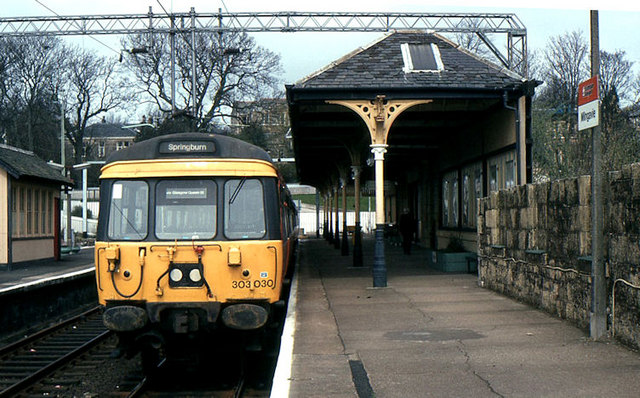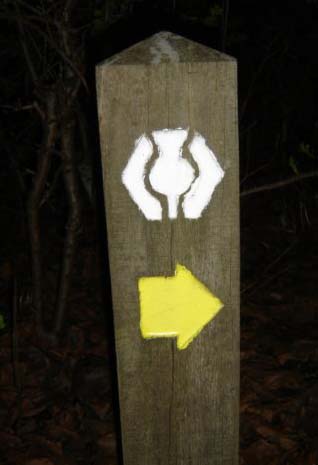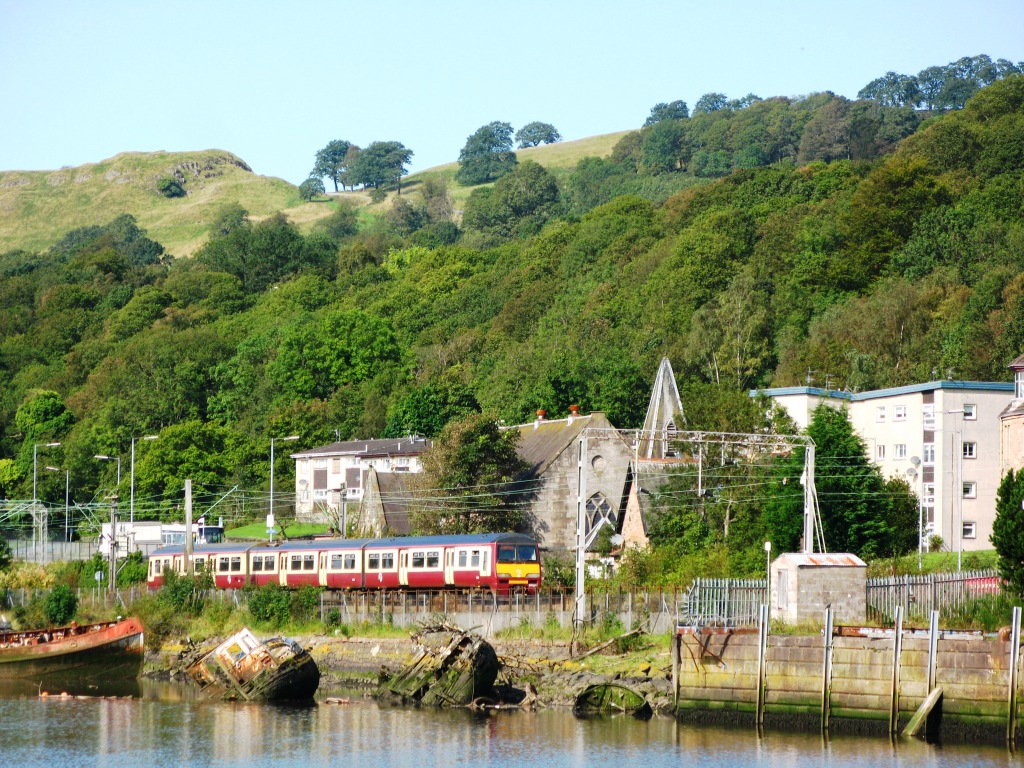|
Milngavie
Milngavie ( ; gd, Muileann-Ghaidh) is a town in East Dunbartonshire, Scotland and a suburb of Glasgow. It is on the Allander Water, at the northwestern edge of Greater Glasgow, and about from Glasgow city centre. It neighbours Bearsden. Milngavie is a commuter town, with much of its working population travelling to Glasgow to work or study. The town is served by Milngavie railway station on the North Clyde Line of the Strathclyde Passenger Transport, SPT rail network, which links it to Central Glasgow. In 2018 the Scottish Government published statistics for the town showing that the population increased to 13,537 in 6,062 households. The town is also a popular retirement location, with a high number of elderly people living there. The ''Milngavie and Bearsden Herald'', owned by Johnston Press, is a weekly newspaper that covers local events from the schools, town halls, community and government in the area. The paper was established in 1901 and is printed every Wednesday, to be ... [...More Info...] [...Related Items...] OR: [Wikipedia] [Google] [Baidu] |
Bearsden
Bearsden () is a town in East Dunbartonshire, Scotland, on the northwestern fringe of Greater Glasgow. Approximately from Glasgow city centre, Glasgow City Centre, the town is effectively a suburb, and its housing development coincided with the 1863 introduction of a railway line. The town was named after Bearsden railway station, which was named after a nearby cottage. Bearsden was ranked the seventh-wealthiest area in Britain in a 2005 survey, and has the least social housing of any town in Scotland. The Roman Empire, Roman Antonine Wall runs through the town, and the remains of a military thermae, bath house can be seen near the town centre. In 1649, the first New Kilpatrick parish church was built, which became the centre of administration for the area. The town's official Scottish Gaelic language, Gaelic name ''Cille Phàdraig Ùr'' (meaning "new church of Patrick") reflects the name of the parish. By the early 20th century, a town had grown, with large townhouses, prima ... [...More Info...] [...Related Items...] OR: [Wikipedia] [Google] [Baidu] |
Clydebank And Milngavie (Scottish Parliament Constituency)
Clydebank and Milngavie (Gaelic: ''Bruach Chluaidh agus Muileann-Ghaidh'') is a constituency of the Scottish Parliament covering part of the council areas of East Dunbartonshire and West Dunbartonshire. It elects one Member of the Scottish Parliament (MSP) by the first past the post method of election.It is also one of ten constituencies in the West Scotland electoral region, which elects seven additional members, in addition to the ten constituency MSPs, to produce a form of proportional representation for the region as a whole. The current member is Marie McNair of the Scottish National Party (SNP), who has held the seat since the 2021 Scottish Parliament election. Electoral region The other nine constituencies of the West Scotland region are Cunninghame North, Cunninghame South, Dumbarton, Eastwood, Greenock and Inverclyde, Paisley, Renfrewshire North and West, the Renfrewshire South and Strathkelvin and Bearsden. The region covers part of the Argyll and Bu ... [...More Info...] [...Related Items...] OR: [Wikipedia] [Google] [Baidu] |
Milngavie Railway Station
, symbol_location = gb , symbol = rail , image = Train terminates at Milngavie (geograph 5819031).jpg , borough = Milngavie, East Dunbartonshire , country = Scotland , coordinates = , grid_name = Grid reference , grid_position = , manager = ScotRail , platforms = 2 , code = MLN , years = April 1863 , events = Opened , mpassengers = , footnotes = Passenger statistics from the Office of Rail and Road Milngavie railway station serves the town of Milngavie, East Dunbartonshire, near Glasgow in Scotland. The station is sited from Glasgow Queen Street, measured via Maryhill. The station is managed by ScotRail, who also operate all services at the station, along the North Clyde and Argyle lines. Its principal purpose today is as a commuter station for people working in Glasgow city centre. The station itself is a category B listed building. History The station was opened in April 1863, and was then part of the Glasgow and Milngavie Junction Railway. Orig ... [...More Info...] [...Related Items...] OR: [Wikipedia] [Google] [Baidu] |
West Highland Way
The West Highland Way ( gd, Slighe na Gàidhealtachd an Iar) is a linear long-distance route in Scotland. It is long, running from Milngavie north of Glasgow to Fort William in the Scottish Highlands, with an element of hill walking in the route. The trail, which opened in 1980, was Scotland's first officially designated Long Distance Route, and is now designated by NatureScot as one of Scotland's Great Trails. It is primarily intended as a long distance walking route, and whilst many sections are suitable for mountain biking and horseriding there are obstacles and surfaces that will require these users to dismount in places. It is managed by the West Highland Way Management Group (WHWMG) consisting of the local authorities for East Dunbartonshire, Stirling, Argyll and Bute and Highland, alongside the Loch Lomond and The Trossachs National Park Authority and NatureScot. About 120,000 people use the path every year, of whom about 36,000 walk the entire route. The path is esti ... [...More Info...] [...Related Items...] OR: [Wikipedia] [Google] [Baidu] |
North Clyde Line
The North Clyde Line (defined by Network Rail as the ''Glasgow North Electric Suburban'' line) is a suburban railway in West Central Scotland. The route is operated by ScotRail Trains. As a result of the incorporation of the Airdrie–Bathgate rail link and the Edinburgh–Bathgate line, this route has become the fourth rail link between Glasgow and Edinburgh. Route The North Clyde Line (known as Dunbartonshire - Glasgow, Cumbernauld and Falkirk Grahamston in timetables), electrified by British Rail in 1960, ran east–west through the Greater Glasgow conurbation, linking northern Lanarkshire with western Dunbartonshire, by way of the city centre. Fifty years later, in 2010, the line was extended by Network Rail east from Airdrie, by way of re-opening the line to Bathgate meeting up with the line re-opened by British Rail from Edinburgh. The main core of the route runs from to via and Glasgow Queen Street (Low Level). To the east of the Glasgow city centre, there i ... [...More Info...] [...Related Items...] OR: [Wikipedia] [Google] [Baidu] |
East Dunbartonshire
East Dunbartonshire ( sco, Aest Dunbartanshire; gd, Siorrachd Dhùn Bhreatainn an Ear) is one of the 32 council areas of Scotland. It borders the north of Glasgow and contains many of the affluent areas to the north of the city, including Bearsden, Milngavie, Milton Of Campsie, Balmore and Torrance, as well as many of the city's commuter towns and villages. East Dunbartonshire also shares borders with North Lanarkshire, Stirling and West Dunbartonshire. The council area covers parts of the historic counties of Dunbartonshire, Lanarkshire and Stirlingshire. The council area was formed in 1996, as a result of the Local Government etc. (Scotland) Act 1994, from the former Bearsden and Milngavie district and most of the former Strathkelvin district (all areas except Chryston and Auchinloch, which became part of North Lanarkshire council area), within the wider Strathclyde region. Demographics East Dunbartonshire council area has low levels of deprivation, with relatively low u ... [...More Info...] [...Related Items...] OR: [Wikipedia] [Google] [Baidu] |
East Dunbartonshire (UK Parliament Constituency)
East Dunbartonshire is a county constituency of the House of Commons of the Parliament of the United Kingdom (Westminster). It elects one Member of Parliament (MP) by the first past the post system of election. The seat is possibly best known for formerly being the constituency of Jo Swinson, the former Leader of the Liberal Democrats who was defeated at the 2019 general election. The current MP for the constituency is Amy Callaghan of the Scottish National Party (SNP). The current constituency was first used at the 2005 general election. There was also an earlier East Dunbartonshire constituency, from 1950 to 1983. Constituency profile The constituency covers the northern edge of Greater Glasgow, and includes commuter towns on the North Clyde and Croy railway corridors. Since 1974 the constituency has been represented by all four of the main political parties in Scotland. Boundaries Current The existing constituency was created as a result of the Fifth Periodical ... [...More Info...] [...Related Items...] OR: [Wikipedia] [Google] [Baidu] |
Glasgow
Glasgow ( ; sco, Glesca or ; gd, Glaschu ) is the most populous city in Scotland and the fourth-most populous city in the United Kingdom, as well as being the 27th largest city by population in Europe. In 2020, it had an estimated population of 635,640. Straddling the border between historic Lanarkshire and Renfrewshire, the city now forms the Glasgow City Council area, one of the 32 council areas of Scotland, and is governed by Glasgow City Council. It is situated on the River Clyde in the country's West Central Lowlands. Glasgow has the largest economy in Scotland and the third-highest GDP per capita of any city in the UK. Glasgow's major cultural institutions – the Burrell Collection, Kelvingrove Art Gallery and Museum, the Royal Conservatoire of Scotland, the Royal Scottish National Orchestra, Scottish Ballet and Scottish Opera – enjoy international reputations. The city was the European Capital of Culture in 1990 and is notable for its architecture, cult ... [...More Info...] [...Related Items...] OR: [Wikipedia] [Google] [Baidu] |
Strathclyde Region
Strathclyde ( in Gaelic, meaning "strath (valley) of the River Clyde") was one of nine former local government regions of Scotland created in 1975 by the Local Government (Scotland) Act 1973 and abolished in 1996 by the Local Government etc. (Scotland) Act 1994. The Strathclyde region had 19 districts. The region was named after the medieval Kingdom of Strathclyde but covered a broader geographic area than its namesake. Functions The area was on the west coast of Scotland and stretched from the Highlands in the north to the Southern Uplands in the south. As a local government region, its population, in excess of 2.5 million, was by far the largest of the regions and contained half of the nation's total. The Region was responsible for education (from nursery to colleges); social work; police; fire; sewage; strategic planning; roads; transport – and, therefore, employed almost 100,000 public servants (almost half were teachers, lecturers and others in the education se ... [...More Info...] [...Related Items...] OR: [Wikipedia] [Google] [Baidu] |
Glasgow Corporation Tramways
Glasgow Corporation Tramways were formerly one of the largest urban tram, tramway systems in Europe. Over 1000 municipally-owned trams served the city of Glasgow, Scotland, with over 100 route miles (160 route kilometres) by 1922. The system closed in 1962 and was the last city tramway in Great Britain (prior to the construction of new systems in the 1990s). Creation The Glasgow Street Tramways Act was enacted by Parliament of the United Kingdom, Parliament in 1870. This legislation allowed Politics of Glasgow, Glasgow Town Council to decide whether or not to have tramways within Glasgow. In 1872, the Town Council laid a route from St George's Cross, Glasgow, St George's Cross to Eglinton Toll (via New City Road, Cambridge Street, Sauchiehall Street, Renfield Street and the Glasgow Bridge, Glasgow, Jamaica Bridge). [...More Info...] [...Related Items...] OR: [Wikipedia] [Google] [Baidu] |
New Kilpatrick
New Kilpatrick, (also known as East Kilpatrick or Easter Kilpatrick) is an ecclesiastical Parish and former Civil Parish in Dunbartonshire. It was formed in 1649 from the eastern half of the parish of Kilpatrick (also known as Kirkpatrick), the western half forming Old Kilpatrick. New Kilpatrick is also a disused name for the town of Bearsden. Originally spanning a large area from Strathblane in the North to Baldernock and Summerston (on the River Kelvin) in the East, down to Anniesland in the South and Yoker and Duntocher in the West, a quarter of the parish was once in the county of Stirlingshire. The geography of the area has supported mining, iron-working and quarrying in the past, but these are no longer economically viable, and much of the area functions as suburbs of Glasgow. Local government of the area was once the responsibility of the kirk, but is now administered by East Dunbartonshire, Glasgow and Stirlingshire councils. The name New Kilpatrick was dropped from gener ... [...More Info...] [...Related Items...] OR: [Wikipedia] [Google] [Baidu] |
Allander Water
The Allander Water ( gd, Uisge Alandair) is a river in East Dunbartonshire and Stirling, Scotland, and one of the three main tributaries of the River Kelvin, the others being the Glazert Water and the Luggie Water. It flows through Milngavie. See also *List of places in East Dunbartonshire ''Map of places in East Dunbartonshire compiled from this list'':See the list of places in Scotland for places in other counties. This List of places in East Dunbartonshire is a list of links for any town, village and hamlet in the East Dunbarton ... * List of places in Stirling External linksRCAHMS record of Craigmaddie, Allander Water, Valve chamber [...More Info...] [...Related Items...] OR: [Wikipedia] [Google] [Baidu] |
.jpg)




